Fraud Detection on Bank Payments - Classification
Context
This Dataset taken from Kaggle
Original paper
Lopez-Rojas, Edgar Alonso ; Axelsson, Stefan Banksim: A bank payments simulator for fraud detection research Inproceedings 26th European Modeling and Simulation Symposium, EMSS 2014, Bordeaux, France, pp. 144–152, Dime University of Genoa, 2014, ISBN: 9788897999324. https://www.researchgate.net/publication/265736405_BankSim_A_Bank_Payment_Simulation_for_Fraud_Detection_Research
Attributes Information
Step: This feature represents the day from the start of simulation.
It has 180 steps so simulation ran for virtually 6 months.
Customer: This feature represents the customer id
Age: Categorized age
0: <= 18,
1: 19-25,
2: 26-35,
3: 36-45,
4: 46-55,
5: 56-65,
6: > 65
U: Unknown
zipCodeOrigin: The zip code of origin/source.
Merchant: The merchant's id
zipMerchant: The merchant's zip code
Gender: Gender for customer
E : Enterprise,
F: Female,
M: Male,
U: Unknown
Category: Category of the purchase.
Amount: Amount of the purchase
Fraud: Target variable which shows if the transaction fraudulent(1) or benign(0)
import pandas as pd
import numpy as np
import matplotlib.pyplot as plt
import seaborn as sns
import re
import ppscore as pps
from imblearn.pipeline import Pipeline
from imblearn.over_sampling import SMOTE
from imblearn.under_sampling import NearMiss
from sklearn.preprocessing import StandardScaler, OneHotEncoder
from sklearn.compose import ColumnTransformer
from sklearn.metrics import classification_report, average_precision_score
import warnings
warnings.filterwarnings('ignore')
from sklearn.linear_model import LogisticRegression
from sklearn.ensemble import RandomForestClassifier
from sklearn.model_selection import RandomizedSearchCV, train_test_split, GridSearchCV
from jcopml.tuning import random_search_params as rsp
from jcopml.tuning.space import Real, Integer
from jcopml.plot import plot_pr_curve
from xgboost import XGBClassifier
sns.set_style('whitegrid')
df = pd.read_csv('bs140513_032310.csv')
df.shape
(594643, 10)
It’s a huge dataset.
df.head()
| step | customer | age | gender | zipcodeOri | merchant | zipMerchant | category | amount | fraud | |
|---|---|---|---|---|---|---|---|---|---|---|
| 0 | 0 | 'C1093826151' | '4' | 'M' | '28007' | 'M348934600' | '28007' | 'es_transportation' | 4.55 | 0 |
| 1 | 0 | 'C352968107' | '2' | 'M' | '28007' | 'M348934600' | '28007' | 'es_transportation' | 39.68 | 0 |
| 2 | 0 | 'C2054744914' | '4' | 'F' | '28007' | 'M1823072687' | '28007' | 'es_transportation' | 26.89 | 0 |
| 3 | 0 | 'C1760612790' | '3' | 'M' | '28007' | 'M348934600' | '28007' | 'es_transportation' | 17.25 | 0 |
| 4 | 0 | 'C757503768' | '5' | 'M' | '28007' | 'M348934600' | '28007' | 'es_transportation' | 35.72 | 0 |
Exploratory Data Analysis
df.describe()
| step | amount | fraud | |
|---|---|---|---|
| count | 594643.000000 | 594643.000000 | 594643.000000 |
| mean | 94.986827 | 37.890135 | 0.012108 |
| std | 51.053632 | 111.402831 | 0.109369 |
| min | 0.000000 | 0.000000 | 0.000000 |
| 25% | 52.000000 | 13.740000 | 0.000000 |
| 50% | 97.000000 | 26.900000 | 0.000000 |
| 75% | 139.000000 | 42.540000 | 0.000000 |
| max | 179.000000 | 8329.960000 | 1.000000 |
pd.DataFrame({'dataFeatures' : df.columns, 'dataType' : df.dtypes.values,
'null' : [df[i].isna().sum() for i in df.columns],
'nullPct' : [((df[i].isna().sum()/len(df[i]))*100).round(2) for i in df.columns],
'Nunique' : [df[i].nunique() for i in df.columns],
'uniqueSample' : [list(pd.Series(df[i].unique()).sample()) for i in df.columns]}).reset_index(drop = True)
| dataFeatures | dataType | null | nullPct | Nunique | uniqueSample | |
|---|---|---|---|---|---|---|
| 0 | step | int64 | 0 | 0.0 | 180 | [56] |
| 1 | customer | object | 0 | 0.0 | 4112 | ['C1340235335'] |
| 2 | age | object | 0 | 0.0 | 8 | ['3'] |
| 3 | gender | object | 0 | 0.0 | 4 | ['M'] |
| 4 | zipcodeOri | object | 0 | 0.0 | 1 | ['28007'] |
| 5 | merchant | object | 0 | 0.0 | 50 | ['M1294758098'] |
| 6 | zipMerchant | object | 0 | 0.0 | 1 | ['28007'] |
| 7 | category | object | 0 | 0.0 | 15 | ['es_home'] |
| 8 | amount | float64 | 0 | 0.0 | 23767 | [253.67] |
| 9 | fraud | int64 | 0 | 0.0 | 2 | [0] |
df['fraud'].value_counts(normalize = True)
0 0.987892
1 0.012108
Name: fraud, dtype: float64
As we can see, just 1% who fraud the bank payments. Its an highly imbalanced, so I’ll perform SMOTE (Synthetic Minority Over-sampling Technique) in the modeling part. And we need to be careful to choose an evaluation metric, where accuracy and ROC-AUC doesnt work anymore.
I’m a little bit curious, what most selected categories for fraudsters?
df.groupby('category').mean()['fraud']*100
category
'es_barsandrestaurants' 1.882944
'es_contents' 0.000000
'es_fashion' 1.797335
'es_food' 0.000000
'es_health' 10.512614
'es_home' 15.206445
'es_hotelservices' 31.422018
'es_hyper' 4.591669
'es_leisure' 94.989980
'es_otherservices' 25.000000
'es_sportsandtoys' 49.525237
'es_tech' 6.666667
'es_transportation' 0.000000
'es_travel' 79.395604
'es_wellnessandbeauty' 4.759380
Name: fraud, dtype: float64
Looks like leisure and travel category are the most selected categories for fraudsters. But why?
df[['amount', 'category']].boxplot(by = 'category', figsize = (20,7))
plt.tight_layout()
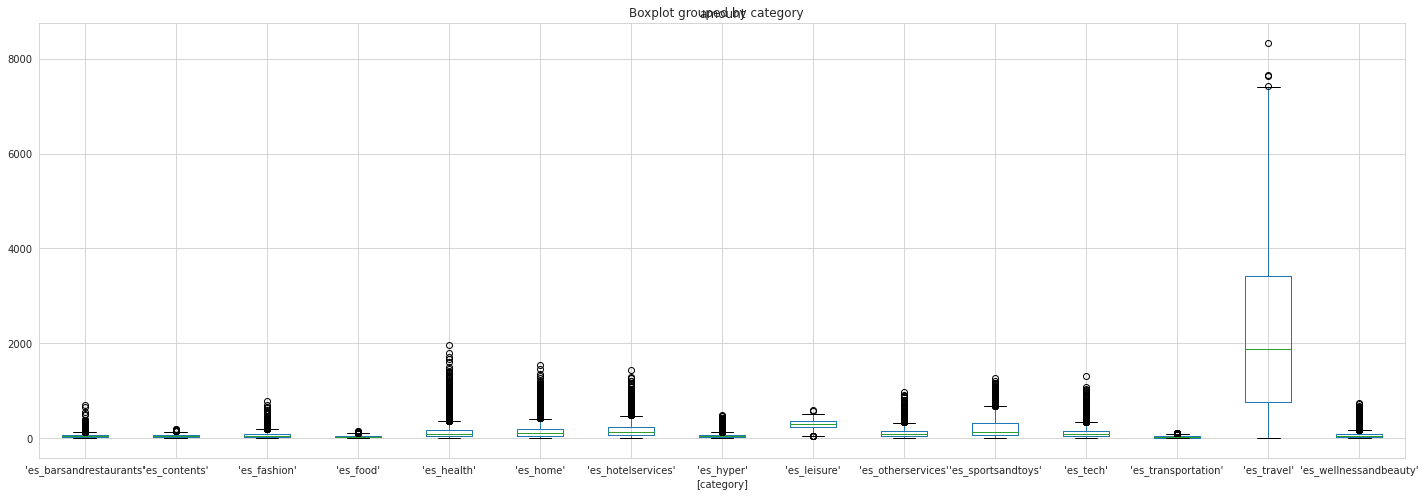
df.groupby('category').mean().sort_values('amount', ascending = False)
| step | amount | fraud | |
|---|---|---|---|
| category | |||
| 'es_travel' | 85.104396 | 2250.409190 | 0.793956 |
| 'es_leisure' | 84.667335 | 288.911303 | 0.949900 |
| 'es_sportsandtoys' | 81.332834 | 215.715280 | 0.495252 |
| 'es_hotelservices' | 92.966170 | 205.614249 | 0.314220 |
| 'es_home' | 89.760322 | 165.670846 | 0.152064 |
| 'es_otherservices' | 70.445175 | 135.881524 | 0.250000 |
| 'es_health' | 100.636211 | 135.621367 | 0.105126 |
| 'es_tech' | 95.034177 | 120.947937 | 0.066667 |
| 'es_fashion' | 95.426092 | 65.666642 | 0.017973 |
| 'es_wellnessandbeauty' | 90.658094 | 65.511221 | 0.047594 |
| 'es_hyper' | 77.837652 | 45.970421 | 0.045917 |
| 'es_contents' | 99.633898 | 44.547571 | 0.000000 |
| 'es_barsandrestaurants' | 75.210576 | 43.461014 | 0.018829 |
| 'es_food' | 107.100861 | 37.070405 | 0.000000 |
| 'es_transportation' | 94.953059 | 26.958187 | 0.000000 |
I see. Leisure and travel are two highest category in amount features. Fraudsters choose the categories which people spend more. And if we see the boxplot, we can see, in the travel category, it can be seen that he has a great variety amount of purchase, it can be one of the reason fraudsters choose this category. He/she will be harder to get caught.
df.groupby('age').mean()['fraud']*100
age
'0' 1.957586
'1' 1.185254
'2' 1.251401
'3' 1.192815
'4' 1.293281
'5' 1.095112
'6' 0.974826
'U' 0.594228
Name: fraud, dtype: float64
That’s smart… Fraudsters using fake identity, with <= 18yo, and as I know, we cannot imprison people under the age of 18. So maybe, Fraudsters think, it would be less consequences if they use fake identity, show how young they are.
Feature Importances
I’m used Predictive Power Score to do feature selection and to see feature importances.
plt.figure(figsize = (10, 5))
df_predictors = pps.predictors(df, y="fraud")
sns.barplot(data=df_predictors, x="x", y="ppscore")
plt.tight_layout()
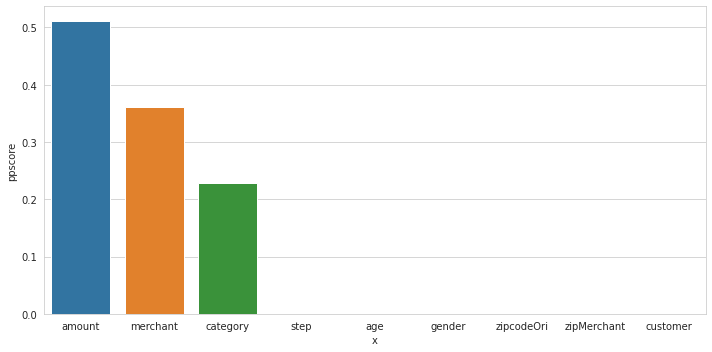
Dataset Splitting
X = df.drop(columns= 'fraud')
y = df['fraud']
X_train, X_test, y_train, y_test = train_test_split(X, y, test_size=0.2, stratify=y, random_state=101)
X_train.shape, X_test.shape, y_train.shape, y_test.shape
((475714, 9), (118929, 9), (475714,), (118929,))
Preprocessing
numerical = Pipeline([
('scaler', StandardScaler())
])
categorical = Pipeline([
('onehot', OneHotEncoder(handle_unknown = 'ignore'))
])
preprocessor = ColumnTransformer([
('numerical', numerical, ['amount']),
('categorical', categorical, ['category', 'merchant', 'age', 'zipMerchant'])
])
Modeling
I’ll perform SMOTE. And my objective is, I want to have a model with high Average Precision Score.
RandomizedSearchCV
Logistic Regresion
logreg_params = {
'algo__fit_intercept': [True, False],
'algo__C': Real(low=-2, high=2, prior='log-uniform')
}
SMOTE
pipeline = Pipeline([
('prep', preprocessor),
('sm', SMOTE(sampling_strategy = 0.8)),
('algo', LogisticRegression(solver='lbfgs', n_jobs=-1, random_state=101))
])
logreg = RandomizedSearchCV(pipeline, logreg_params, cv= 3, scoring= 'average_precision', random_state=101)
logreg.fit(X_train, y_train)
print(logreg.best_params_)
print(logreg.score(X_train, y_train), logreg.best_score_, logreg.score(X_test, y_test))
{'algo__C': 1.3691263238256033, 'algo__fit_intercept': True}
0.8759206521802209 0.8754256285729967 0.862514901182484
y_pred = logreg.best_estimator_.predict(X_test)
print(classification_report(y_test, y_pred))
precision recall f1-score support
0 1.00 0.97 0.99 117489
1 0.30 0.98 0.45 1440
accuracy 0.97 118929
macro avg 0.65 0.97 0.72 118929
weighted avg 0.99 0.97 0.98 118929
plot_pr_curve(X_train, y_train, X_test, y_test, logreg)
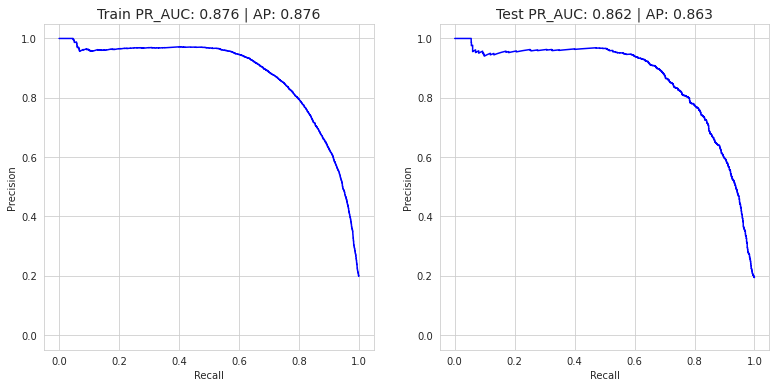
Manual Tuning
Unfortunately, I’m not used RandomizedSearchCV for another model except Logistic Regression. The reason is: This is a huge dataset (+ SMOTE) so using RandomizedSearchCV it cost many of time. And I’m not sure my laptop can handle it. So I decided to tuning my model by manually.
Random Forest
rf = Pipeline([
('prep', preprocessor),
('sm', SMOTE(sampling_strategy = 0.8)),
('algo', RandomForestClassifier(n_estimators=150,max_depth=7,random_state=101))
])
rf.fit(X_train, y_train)
y_pred = rf.predict(X_test)
y_pred_proba = rf.predict_proba(X_test)
print(classification_report(y_test, y_pred))
print('Random Forest Classifier => AP score: {}'.format(average_precision_score(y_test, y_pred_proba[:,1])))
precision recall f1-score support
0 1.00 0.94 0.97 117489
1 0.18 0.99 0.30 1440
accuracy 0.94 118929
macro avg 0.59 0.97 0.63 118929
weighted avg 0.99 0.94 0.96 118929
Random Forest Classifier => AP score: 0.7607888216219187
plot_pr_curve(X_train, y_train, X_test, y_test, rf)
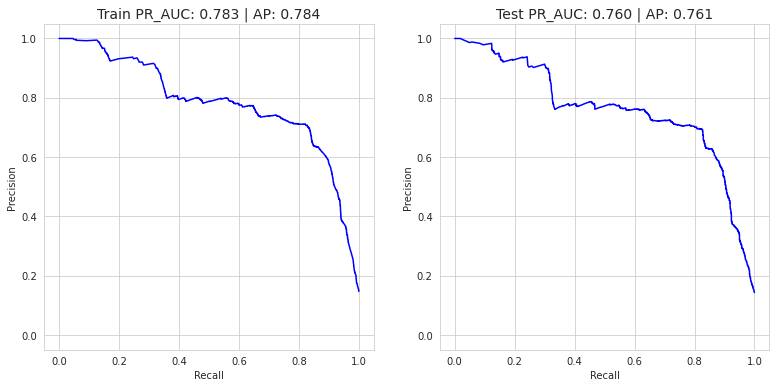
XGBoost
xgb = Pipeline([
('prep', preprocessor),
('sm', SMOTE(sampling_strategy = 0.8)),
('algo', XGBClassifier(max_depth=7, learning_rate=0.08, n_estimators=300,
gamma = 1, subsample= 0.5, colsample_bytree=1, random_state = 101))
])
xgb.fit(X_train, y_train)
y_pred = xgb.predict(X_test)
y_pred_proba = xgb.predict_proba(X_test)
print(classification_report(y_test, y_pred))
print('XGBoost Classifier => AP score: {}'.format(average_precision_score(y_test, y_pred_proba[:,1])))
precision recall f1-score support
0 1.00 0.98 0.99 117489
1 0.35 0.96 0.51 1440
accuracy 0.98 118929
macro avg 0.67 0.97 0.75 118929
weighted avg 0.99 0.98 0.98 118929
XGBoost Classifier => AP score: 0.8957515556626793
plot_pr_curve(X_train, y_train, X_test, y_test, xgb)
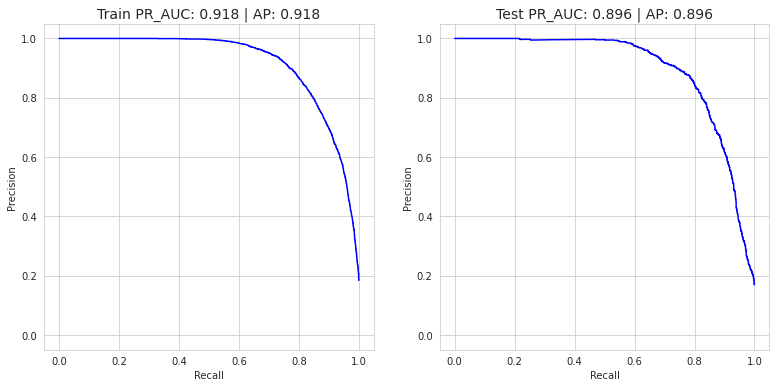
Conclusion
Based on AP (Average Precision) Score, we can say, XGBoost Classifier is the best model between Logistic Regression and Random Forest Classifier.
